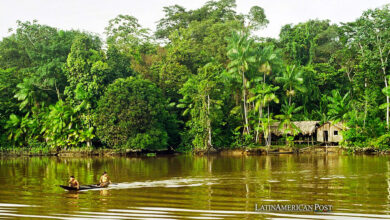What is Happening with the Pink Dolphins in South America?
Hunting, Gold mining and Deforestation are Negatively Impacting Pink Dolphins. Today it is an Endangered Species.

Photo: Unsplash
LatinAmerican Post | Brandon Martínez Salazar
Listen to this article
Leer en español: ¿Qué está pasando con los delfines rosados en Suramérica?
A recent investigation has highlighted the danger to which pink dolphins are exposed in South America. This species, which is known by different names such as boto, bufe or Amazon dolphin, is an odontocete cetacean mammal that lives along the Amazon River, the Orinoco River and the Madeira River.
This species, which is currently considered in danger of extinction, has a special function for the aquatic ecosystems of the rivers. So the importance of dolphins is that they are the ones who indicate the health of the river, that is, their presence is a positive signal about the quality of the basin. Another function they fulfill is that they serve as an umbrella, because by protecting them, other species that are in their habitat are protected.
Economically, it is a good fishing indicator. Culturally, for some populations of the Amazon and Orinoquía, the dolphin is associated with supernatural powers and inspires deep respect. Also, for the tourism sector they are important since visitors who come to the places where they live want to see dolphins in the river.
However, the reality of this species is grim and if something is not done soon, it will most likely disappear.
How are they being threatened?
According to the World Wide Fund for Nature, seventeen scientific organizations did an in-depth investigation where they found fifty-seven sites where illegal practices are carried out with pink dolphins in the Amazon, Orinoco and Tocantins; whose conclusions set off alarms about this animal species.
Scientific research has shown that hunting is the main cause that these mammals are disappearing. According to the investigative article, the hunting of the pink dolphin is to be used as bait for the speck fish, a species that has been prohibited in Colombia since 2021 due to its high levels of mercury. On the other hand, gold mining and uncontrollable deforestation in the Amazon have also negatively impacted dolphins and the ecosystems they inhabit.
What was found in the investigation?
The study was carried out by 23 people from different countries in which they identified 57 places where illegal practices that threaten pink dolphins are carried out. Now, of those places that are specified in the investigation, 33 correspond to the Amazon basin, 22 to the Orinoco River, another 2 in Tocantins and 2 on the Caribbean coast of Brazil.
In the statistical results, it was established that 64% of the dolphin hunt was intended to be used for bushmeat, 35% for medicinal purposes and 1% for human consumption. In addition, it was shown that their natural habitat is being intervened by the construction of dams on the three rivers, especially in the Amazon, where there are already 307.
How can pink dolphins be protected?
Although the research is worrying and warns about the high probability that the dolphin population will continue to decline in the basins, experts point out that it is essential that policies be implemented to mitigate the social, economic and cultural conditions that are directly related to the illegal practices defined in the study and that put aquatic ecosystems at risk.
According to Saulo Usma, a freshwater specialist at WWF Colombia (the same web portal details), it is important that the creation and proper management of protected areas be implemented in collaboration with the communities to safeguard cetaceans in transboundary areas.




